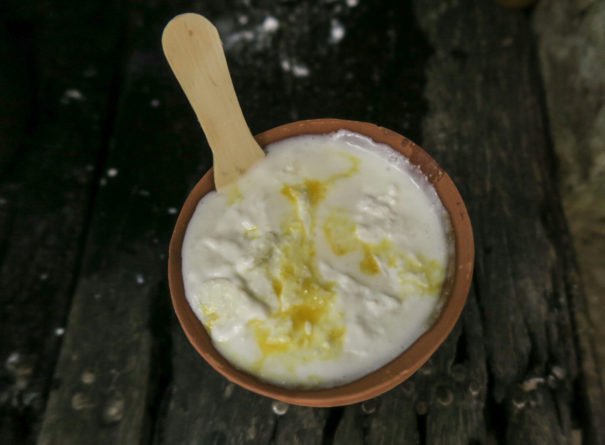
You’re Making Something Special When People Are Willing to Overlook the Dead Bodies

You’re Making Something Special When People Are Willing to Overlook the Dead Bodies
Lassi in Varanasi
“Rama is real! Rama is real!” groups of men chant as they rush down the alley, carrying dead bodies over their shoulders. On the ground, cakes of fresh cow dung mix with trickles of black, muddy water and the torn paper cups of a hundred sweet chais. I’m standing on a corner of Varanasi Old Town near the Manikarnika burning ghat, India’s holiest cremation site.
Here, all day long, dozens of Indian families pass every few minutes, carrying dead bodies on their shoulders covered in shimmering silk. They keep walking to the ghat on their mission, disregarding the wandering holy cows, the piles of dung, and the line of people who come to this busy junction for a very different reason: to have breakfast, in the form of a cup of Varanasi’s best lassi. I’m one of the latter. And I’m hungry.
Blue Lassi, an 80-year-old, family-run establishment, witnesses the steady march of the dead from two nicely decorated, international-traveller-oriented holes in the wall along the front and back of the alley. Blue Lassi is easy to find, because there are dozens of colorful hand-painted directions to this Lonely Planet-approved spot all over the Old Town’s alleys. The father and his son take turns sitting on the concrete cube next to the steps out front, twirling a stick into an aluminum pot and dishing up the fruity blend that always pleases the travelers waiting inside. It’s 80 rupees for the banana-topped lassi, up to about 160 for the chocolate and almond sprinkle: a swing between $1 and $2.5.
Next to Blue Lassi, there’s an even smaller hole in the wall: Real Lassi, which has rave reviews scribbled in Korean, English, Chinese, Spanish, and Hebrew on its tattered walls, dishes up the “real” stuff at 30 rupees, a fraction of Blue Lassi’s foreigner-oriented prices. The lassis are less creamy, come without fruit toppings, and—in the traditional Indian style—have slices of fresh curd skin floating on the surface. Babu, the young manager, pours three spoonfuls of sugar into each one.
“Trust me, Real and Blue Lassi are not competitors. We complement each other,” Babu says as another body is carried past us down to the sacred river. I’m not used to eating this close to the dead, but Babu’s lassi is so delicious that despite the somber parade, I finish my first cup in minutes, and order another. Whether you like Blue or Real, these lassis are the best way to kickstart another day in Varanasi.